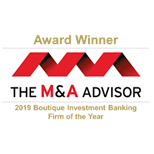As a business owner, it’s essential that you do your homework, engage in plenty of pre-sale planning, and get the advice of experts before making the biggest business decision of your career – selling your company. This includes having an understanding of the different forms an M&A offer can take and the way they will function as you move forward. Knowledge about the components of a deal structure will help you maximize value during the negotiation process.
Let’s discuss the basic components of deal structure and how they align with various seller objectives.
Cash is King in Any Deal Structure
The old adage “cash is king” is more than a tired cliche; it’s a good guideline when negotiating an M&A deal. If you’ve owned a business for 30+ years, you have an illiquid asset. Selling it is the likely the biggest liquidity event you’ll ever have in your life.
An offer of cash up front is the most secure consideration a business owner can receive. While publicly traded companies often create intricate deal structures that are heavy on stock considerations, for the lower- to middle-market, the majority of any deal will typically be front-loaded with cash.
Keeping the Seller Onboard with Equity
Depending on the seller’s objectives, they may be content to accept part of the purchase price in the form of equity. If a seller plans to stay onboard in the new company, this gives them a financial interest in the business. If the buyer is a private equity firm that sells the company again in the future, this could provide the seller with a “second bite at the apple.” In many cases, the second or third time selling an equity stake could provide a greater value than the first sale transaction. This is all dependent on who the buyer is and what direction they’d like to take the company.
On the buyer’s behalf, a seller that’s willing to take equity as part of a transaction demonstrates that they believe in the business and are willing to reinvest.
Seller Notes Provide Flexibility
A deal structure that involves a seller note will contain a debt component. Along with receiving cash or other considerations being offered, the seller could agree to assume a portion of the purchase price as a note on the business to increase the valuation. The terms of a seller note will vary from one transaction to another. One common factor, however, is that the offer of a seller note often gives a buyer more flexibility in their price. If the two parties are having trouble agreeing on a number, a seller note can be an excellent strategy to make the buyer comfortable with paying a higher price.
Obtaining Additional Compensation With an Earnout
For a seller who would like to stay involved, an earnout may be negotiated into the purchase agreement. An earnout is the ultimate way to ensure that a seller keeps their eye on the ball in regards to the performance of the business. Earnouts are high-level considerations and will contain specific EBITDA targets that will be applicable over the period of time the seller is onboard. If those targets are met, the seller will receive compensation for meeting them.
Bringing It All Together
How do all of these components come together for the perfect deal structure? There isn’t one right answer to this question, as every deal will depend on the owner/seller’s goals and objectives. For an owner who simply wants to sell and retire or move on, it may be more attractive to receive a lower value that involves mostly cash up front. Meanwhile, an owner would like to sell but stay involved in some form may be able to negotiate a higher price by agreeing to hold equity in the business, accepting an earnout, or holding a seller note.
If you’re thinking about selling, the most important step you can take is working to understand what a potential buyer would want and creating a strategy to get your business there (through building a stronger team, cleaning up your financials, addressing issues like client concentration, etc.). The team at MelCap can help with this kind of planning — whether it’s taking place months or even years before you plan to sell.
Next, it’s essential to speak to a wealth manager in order to understand what your lifestyle is and what you need to support it. Can you get to that dollar amount by selling your business?
With these goals and numbers in mind, you’ll be on the path to crafting the perfect deal structure to ensure long-term wealth and success.















